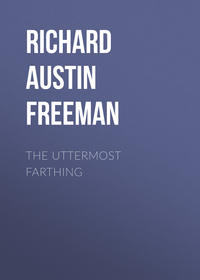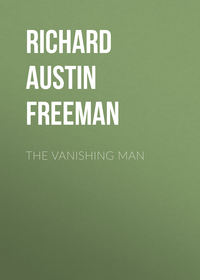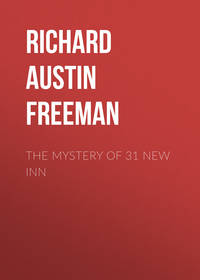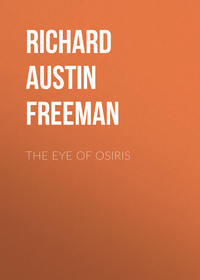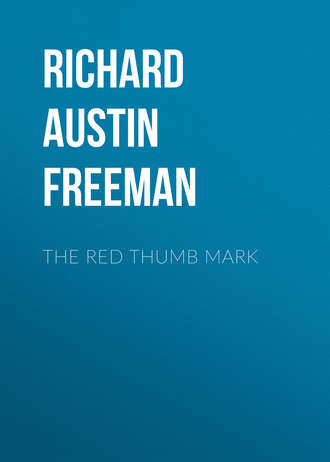 полная версия
полная версияThe Red Thumb Mark
"Is this the paper?" asked the counsel, passing a small slip across to the witness.
"Yes," replied the inspector, after a brief glance at the document.
"What did you do next?"
"I sent a message to Scotland Yard acquainting the Chief of the Criminal Investigation Department with the facts, and then went back to the station. I had no further connection with the case."
Sir Hector sat down, and the judge glanced at Anstey.
"You tell us," said the latter, rising, "that you observed two good-sized drops of blood on the bottom of the safe. Did you notice the condition of the blood, whether moist or dry?"
"The blood looked moist, but I did not touch it. I left it undisturbed for the detective officers to examine."
The next witness called was Sergeant Bates, of the Criminal Investigation Department. He stepped into the box with the same ready, business-like air as the other officer, and, having been sworn, proceeded to give his evidence with a fluency that suggested careful preparation, holding an open notebook in his hand but making no references to it.
"On the tenth of March, at 12.8 p.m., I received instructions to proceed to St. Mary Axe to inquire into a robbery that had taken place there. Inspector Sanderson's report was handed to me, and I read it in the cab on my way to the premises. On arriving at the premises at 12.30 p.m., I examined the safe carefully. It was quite uninjured, and there were no marks of any kind upon it. I tested the locks and found them perfect; there were no marks or indications of any picklock having been used. On the bottom of the inside I observed two rather large drops of a dark fluid. I took up some of the fluid on a piece of paper and found it to be blood. I also found, in the bottom of the safe, the burnt head of a wax match, and, on searching the floor of the office, I found, close by the safe, a used wax match from which the head had fallen. I also found a slip of paper which appeared to have been torn from a perforated block. On it was written in pencil, 'Handed in by Reuben at 7.3 p.m. 9.3.01. J.H.' There were two smears of blood on the paper and the impression of a human thumb in blood. I took possession of the paper in order that it might be examined by the experts. I inspected the office doors and the outer door of the premises, but found no signs of forcible entrance on any of them. I questioned the housekeeper, but obtained no information from him. I then returned to headquarters, made my report and handed the paper with the marks on it to the Superintendent."
"Is this the paper that you found in the safe?" asked the counsel, once more handing the leaflet across.
"Yes; this is the paper."
"What happened next?"
"The following afternoon I was sent for by Mr. Singleton, of the Finger-print Department. He informed me that he had gone through the files and had not been able to find any thumb-print resembling the one on the paper, and recommended me to endeavour to obtain prints of the thumbs of any persons who might have been concerned in the robbery. He also gave me an enlarged photograph of the thumb-print for reference if necessary. I accordingly went to St. Mary Axe and had an interview with Mr. Hornby, when I requested him to allow me to take prints of the thumbs of all the persons employed on the premises, including his two nephews. This he refused, saying that he distrusted finger-prints and that there was no suspicion of anyone on the premises. I asked if he would allow his nephews to furnish their thumb-prints privately, to which he replied, 'Certainly not.'"
"Had you then any suspicion of either of the nephews?"
"I thought they were both open to some suspicion. The safe had certainly been opened with false keys, and as they had both had the real keys in their possession it was possible that one of them might have taken impressions in wax and made counterfeit keys."
"Yes."
"I called on Mr. Hornby several times and urged him, for the sake of his nephews' reputations, to sanction the taking of the thumb-prints; but he refused very positively and forbade them to submit, although I understood that they were both willing. It then occurred to me to try if I could get any help from Mrs. Hornby, and on the fifteenth of March I called at Mr. Hornby's private house and saw her. I explained to her what was wanted to clear her nephews from the suspicion that rested on them, and she then said that she could dispose of those suspicions at once, for she could show me the thumb-prints of the whole family: she had them all in a 'Thumbograph.'"
"A 'Thumbograph'?" repeated the judge. "What is a 'Thumbograph'?"
Anstey rose with the little red-covered volume in his hand.
"A 'Thumbograph,' my lord," said he, "is a book, like this, in which foolish people collect the thumb-prints of their more foolish acquaintances."
He passed the volume up to the judge, who turned over the leaves curiously and then nodded to the witness.
"Yes. She said she had them all in a 'Thumbograph.'"
"Then she fetched from a drawer a small red-covered book which she showed to me. It contained the thumb-prints of all the family and some of her friends."
"Is this the book?" asked the judge, passing the volume down to the witness.
The sergeant turned over the leaves until he came to one which he apparently recognised, and said—
"Yes, m'lord; this is the book. Mrs. Hornby showed me the thumb-prints of various members of the family, and then found those of the two nephews. I compared them with the photograph that I had with me and discovered that the print of the left thumb of Reuben Hornby was in every respect identical with the thumb-print shown in the photograph."
"What did you do then?"
"I asked Mrs. Hornby to lend me the 'Thumbograph' so that I might show it to the Chief of the Finger-print Department, to which she consented. I had not intended to tell her of my discovery, but, as I was leaving, Mr. Hornby arrived home, and when he heard of what had taken place, he asked me why I wanted the book, and then I told him. He was greatly astonished and horrified, and wished me to return the book at once. He proposed to let the whole matter drop and take the loss of the diamonds on himself; but I pointed out that this was impossible as it would practically amount to compounding a felony. Seeing that Mrs. Hornby was so distressed at the idea of her book being used in evidence against her nephew, I promised her that I would return it to her if I could obtain a thumb-print in any other way.
"I then took the 'Thumbograph' to Scotland Yard and showed it to Mr. Singleton, who agreed that the print of the left thumb of Reuben Hornby was in every respect identical with the thumb-print on the paper found in the safe. On this I applied for a warrant for the arrest of Reuben Hornby, which I executed on the following morning. I told the prisoner what I had promised Mrs. Hornby, and he then offered to allow me to take a print of his left thumb so that his aunt's book should not have to be used in evidence."
"How is it, then," asked the judge, "that it has been put in evidence?"
"It has been put in by the defence, my lord," said Sir Hector Trumpler.
"I see," said the judge. "'A hair of the dog that bit him.' The 'Thumbograph' is to be applied as a remedy on the principle that similia similibus curantur. Well?"
"When I arrested him, I administered the usual caution, and the prisoner then said, 'I am innocent. I know nothing about the robbery.'"
The counsel for the prosecution sat down, and Anstey rose to cross-examine.
"You have told us," said he, in his clear musical voice, "that you found at the bottom of the safe two rather large drops of a dark fluid which you considered to be blood. Now, what led you to believe that fluid to be blood?"
"I took some of the fluid up on a piece of white paper, and it had the appearance and colour of blood."
"Was it examined microscopically or otherwise?"
"Not to my knowledge."
"Was it quite liquid?"
"Yes, I should say quite liquid."
"What appearance had it on paper?"
"It looked like a clear red liquid of the colour of blood, and was rather thick and sticky."
Anstey sat down, and the next witness, an elderly man, answering to the name of Francis Simmons, was called.
"You are the housekeeper at Mr. Hornby's premises in St. Mary Axe?" asked Sir Hector Trumpler.
"I am."
"Did you notice anything unusual on the night of the ninth of March?"
"I did not."
"Did you make your usual rounds on that occasion?"
"Yes. I went all over the premises several times during the night, and the rest of the time I was in a room over the private office."
"Who arrived first on the morning of the tenth?"
"Mr. Reuben. He arrived about twenty minutes before anybody else."
"What part of the building did he go to?"
"He went into the private office, which I opened for him. He remained there until a few minutes before Mr. Hornby arrived, when he went up to the laboratory."
"Who came next?"
"Mr. Hornby, and Mr. Walter came in just after him."
The counsel sat down, and Anstey proceeded to cross-examine the witness.
"Who was the last to leave the premises on the evening of the ninth?"
"I am not sure."
"Why are you not sure?"
"I had to take a note and a parcel to a firm in Shoreditch. When I started, a clerk named Thomas Holker was in the outer office and Mr. Walter Hornby was in the private office. When I returned they had both gone."
"Was the outer door locked?"
"Yes."
"Had Holker a key of the outer door?"
"No. Mr. Hornby and his two nephews had each a key, and I have one. No one else had a key."
"How long were you absent?"
"About three-quarters of an hour."
"Who gave you the note and the parcel?"
"Mr. Walter Hornby."
"When did he give them to you?"
"He gave them to me just before I started, and told me to go at once for fear the place should be closed before I got there."
"And was the place closed?"
"Yes. It was all shut up, and everybody had gone."
Anstey resumed his seat, the witness shuffled out of the box with an air of evident relief, and the usher called out, "Henry James Singleton."
Mr. Singleton rose from his seat at the table by the solicitors for the prosecution and entered the box. Sir Hector adjusted his glasses, turned over a page of his brief, and cast a steady and impressive glance at the jury.
"I believe, Mr. Singleton," he said at length, "that you are connected with the Finger-print Department at Scotland Yard?"
"Yes. I am one of the chief assistants in that department."
"What are your official duties?"
"My principal occupation consists in the examination and comparison of the finger-prints of criminals and suspected persons. These finger-prints are classified by me according to their characters and arranged in files for reference."
"I take it that you have examined a great number of finger-prints?"
"I have examined many thousands of finger-prints, and have studied them closely for purposes of identification."
"Kindly examine this paper, Mr. Singleton" (here the fatal leaflet was handed to him by the usher); "have you ever seen it before?"
"Yes. It was handed to me for examination at my office on the tenth of March."
"There is a mark upon it—the print of a finger or thumb. Can you tell us anything about that mark?"
"It is the print of the left thumb of Reuben Hornby, the prisoner at the bar."
"You are quite sure of that?"
"I am quite sure."
"Do you swear that the mark upon that paper was made by the thumb of the prisoner?"
"I do."
"Could it not have been made by the thumb of some other person?"
"No; it is impossible that it could have been made by any other person."
At this moment I felt Juliet lay a trembling hand on mine, and, glancing at her, I saw that she was deathly pale. I took her hand in mine and, pressing it gently, whispered to her, "Have courage; there is nothing unexpected in this."
"Thank you," she whispered in reply, with a faint smile; "I will try; but it is all so horribly unnerving."
"You consider," Sir Hector proceeded, "that the identity of this thumb-print admits of no doubt?"
"It admits of no doubt whatever," replied Mr. Singleton.
"Can you explain to us, without being too technical, how you have arrived at such complete certainty?"
"I myself took a print of the prisoner's thumb—having first obtained the prisoner's consent after warning him that the print would be used in evidence against him—and I compared that print with the mark on this paper. The comparison was made with the greatest care and by the most approved method, point by point and detail by detail, and the two prints were found to be identical in every respect.
"Now it has been proved by exact calculations—which calculations I have personally verified–that the chance that the print of a single finger of any given person will be exactly like the print of the same finger of any other given person is as one to sixty-four thousand millions. That is to say that, since the number of the entire human race is about sixteen thousand millions, the chance is about one to four that the print of a single finger of any one person will be identical with that of the same finger of any other member of the human race.
"It has been said by a great authority—and I entirely agree with the statement—that a complete, or nearly complete, accordance between two prints of a single finger affords evidence requiring no corroboration that the persons from whom they were made are the same.
"Now, these calculations apply to the prints of ordinary and normal fingers or thumbs. But the thumb from which these prints were taken is not ordinary or normal. There is upon it a deep but clean linear scar—the scar of an old incised wound—and this scar passes across the pattern of the ridges, intersecting the latter at certain places and disturbing their continuity at others. Now this very characteristic scar is an additional feature, having a set of chances of its own. So that we have to consider not only the chance that the print of the prisoner's left thumb should be identical with the print of some other person's left thumb—which is as one to sixty-four thousand millions—but the further chance that these two identical thumb-prints should be traversed by the impression of a scar identical in size and appearance, and intersecting the ridges at exactly the same places and producing failures of continuity in the ridges of exactly the same character. But these two chances, multiplied into one another, yield an ultimate chance of about one to four thousand trillions that the prisoner's left thumb will exactly resemble the print of some other person's thumb, both as to the pattern and the scar which crosses the pattern; in other words such a coincidence is an utter impossibility."
Sir Hector Trumpler took off his glasses and looked long and steadily at the jury as though he should say, "Come, my friends; what do you think of that?" Then he sat down with a jerk and turned towards Anstey and Thorndyke with a look of triumph.
"Do you propose to cross-examine the witness?" inquired the judge, seeing that the counsel for the defence made no sign.
"No, my lord," replied Anstey.
Thereupon Sir Hector Trumpler turned once more towards the defending counsel, and his broad, red face was illumined by a smile of deep satisfaction. That smile was reflected on the face of Mr. Singleton as he stepped from the box, and, as I glanced at Thorndyke, I seemed to detect, for a single instant, on his calm and immovable countenance, the faintest shadow of a smile.
"Herbert John Nash!"
A plump, middle-aged man, of keen, though studious, aspect, stepped into the box, and Sir Hector rose once more.
"You are one of the chief assistants in the Finger-print Department, I believe, Mr. Nash?"
"I am."
"Have you heard the evidence of the last witness?"
"I have."
"Do you agree with the statements made by that witness?"
"Entirely. I am prepared to swear that the print on the paper found in the safe is that of the left thumb of the prisoner, Reuben Hornby."
"And you are certain that no mistake is possible?"
"I am certain that no mistake is possible."
Again Sir Hector glanced significantly at the jury as he resumed his seat, and again Anstey made no sign beyond the entry of a few notes on the margin of his brief.
"Are you calling any more witnesses?" asked the judge, dipping his pen in the ink.
"No, my lord," replied Sir Hector. "That is our case."
Upon this Anstey rose and, addressing the judge, said—
"I call witnesses, my lord."
The judge nodded and made an entry in his notes while Anstey delivered his brief introductory speech—
"My lord and gentlemen of the jury, I shall not occupy the time of the Court with unnecessary appeals at this stage, but shall proceed to take the evidence of my witnesses without delay."
There was a pause of a minute or more, during which the silence was broken only by the rustle of papers and the squeaking of the judge's quill pen. Juliet turned a white, scared face to me and said in a hushed whisper—
"This is terrible. That last man's evidence is perfectly crushing. What can possibly be said in reply? I am in despair; oh! poor Reuben! He is lost, Dr. Jervis! He hasn't a chance now."
"Do you believe that he is guilty?" I asked.
"Certainly not!" she replied indignantly. "I am as certain of his innocence as ever."
"Then," said I, "if he is innocent, there must be some means of proving his innocence."
"Yes. I suppose so," she rejoined in a dejected whisper. "At any rate we shall soon know now."
At this moment the usher's voice was heard calling out the name of the first witness for the defence.
"Edmund Horford Rowe!"
A keen-looking, grey-haired man, with a shaven face and close-cut side-whiskers, stepped into the box and was sworn in due form.
"You are a doctor of medicine, I believe," said Anstey, addressing the witness, "and lecturer on Medical Jurisprudence at the South London Hospital?"
"I am."
"Have you had occasion to study the properties of blood?"
"Yes. The properties of blood are of great importance from a medico-legal point of view."
"Can you tell us what happens when a drop of blood—say from a cut finger—falls upon a surface such as the bottom of an iron safe?"
"A drop of blood from a living body falling upon any non-absorbent surface will, in the course of a few minutes, solidify into a jelly which will, at first, have the same bulk and colour as the liquid blood."
"Will it undergo any further change?"
"Yes. In a few minutes more the jelly will begin to shrink and become more solid so that the blood will become separated into two parts, the solid and the liquid. The solid part will consist of a firm, tough jelly of a deep red colour, and the liquid part will consist of a pale yellow, clear, watery liquid."
"At the end, say, of two hours, what will be the condition of the drop of blood?"
"It will consist of a drop of clear, nearly colourless liquid, in the middle of which will be a small, tough, red clot."
"Supposing such a drop to be taken up on a piece of white paper, what would be its appearance?"
"The paper would be wetted by the colourless liquid, and the solid clot would probably adhere to the paper in a mass."
"Would the blood on the paper appear as a clear, red liquid?"
"Certainly not. The liquid would appear like water, and the clot would appear as a solid mass sticking to the paper."
"Does blood always behave in the way you have described?"
"Always, unless some artificial means are taken to prevent it from clotting."
"By what means can blood be prevented from clotting or solidifying?"
"There are two principal methods. One is to stir or whip the fresh blood rapidly with a bundle of fine twigs. When this is done, the fibrin—the part of the blood that causes solidification—adheres to the twigs, and the blood that remains, though it is unchanged in appearance, will remain liquid for an indefinite time. The other method is to dissolve a certain proportion of some alkaline salt in the fresh blood, after which it no longer has any tendency to solidify."
"You have heard the evidence of Inspector Sanderson and Sergeant Bates?"
"Yes."
"Inspector Sanderson has told us that he examined the safe at 10.31 a.m. and found two good-sized drops of blood on the bottom. Sergeant Bates has told us that he examined the safe two hours later, and that he took up one of the drops of blood on a piece of white paper. The blood was then quite liquid, and, on the paper, it looked like a clear, red liquid of the colour of blood. What should you consider the condition and nature of that blood to have been?"
"If it was really blood at all, I should say that it was either defibrinated blood—that is, blood from which the fibrin has been extracted by whipping—or that it had been treated with an alkaline salt."
"You are of opinion that the blood found in the safe could not have been ordinary blood shed from a cut or wound?"
"I am sure it could not have been."
"Now, Dr. Rowe, I am going to ask you a few questions on another subject. Have you given any attention to finger-prints made by bloody fingers?"
"Yes. I have recently made some experiments on the subject."
"Will you give us the results of those experiments?"
"My object was to ascertain whether fingers wet with fresh blood would yield distinct and characteristic prints. I made a great number of trials, and as a result found that it is extremely difficult to obtain a clear print when the finger is wetted with fresh blood. The usual result is a mere red blot showing no ridge pattern at all, owing to the blood filling the furrows between the ridges. But if the blood is allowed to dry almost completely on the finger, a very clear print is obtained."
"Is it possible to recognise a print that has been made by a nearly dry finger?"
"Yes; quite easily. The half-dried blood is nearly solid and adheres to the paper in a different way from the liquid, and it shows minute details, such as the mouths of the sweat glands, which are always obliterated by the liquid."
"Look carefully at this paper, which was found in the safe, and tell me what you see."
The witness took the paper and examined it attentively, first with the naked eye and then with a pocket-lens.
"I see," said he, "two blood-marks and a print, apparently of a thumb. Of the two marks, one is a blot, smeared slightly by a finger or thumb; the other is a smear only. Both were evidently produced with quite liquid blood. The thumb-print was also made with liquid blood."
"You are quite sure that the thumb-print was made with liquid blood?"
"Quite sure."
"Is there anything unusual about the thumb-print?"
"Yes. It is extraordinarily clear and distinct. I have made a great number of trials and have endeavoured to obtain the clearest prints possible with fresh blood; but none of my prints are nearly as distinct as this one."
Here the witness produced a number of sheets of paper, each of which was covered with the prints of bloody fingers, and compared them with the memorandum slip.
The papers were handed to the judge for his inspection, and Anstey sat down, when Sir Hector Trumpler rose, with a somewhat puzzled expression on his face, to cross-examine.
"You say that the blood found in the safe was defibrinated or artificially treated. What inference do you draw from that fact?"
"I infer that it was not dropped from a bleeding wound."
"Can you form any idea how such blood should have got into the safe?"
"None whatever."
"You say that the thumb-print is a remarkably distinct one. What conclusion do you draw from that?"
"I do not draw any conclusion. I cannot account for its distinctness at all."
The learned counsel sat down with rather a baffled air, and I observed a faint smile spread over the countenance of my colleague.
"Arabella Hornby."
A muffled whimpering from my neighbour on the left hand was accompanied by a wild rustling of silk. Glancing at Mrs. Hornby, I saw her stagger from the bench, shaking like a jelly, mopping her eyes with her handkerchief and grasping her open purse. She entered the witness-box, and, having gazed wildly round the court, began to search the multitudinous compartments of her purse.


